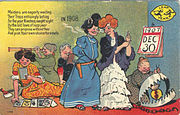Who Invented Leap Years?
Roman general Julius Caesar introduced the first leap years over 2000 years ago. But the Julian calendar had only one rule: any year evenly divisible by four would be a leap year.
This formula produced way too many leap years, but was not corrected until the introduction of the Gregorian calendar more than 1500 years later.
Folk traditions
Roman general Julius Caesar introduced the first leap years over 2000 years ago. But the Julian calendar had only one rule: any year evenly divisible by four would be a leap year.
This formula produced way too many leap years, but was not corrected until the introduction of the Gregorian calendar more than 1500 years later. ]
The following comes from Wikipedia:
A spinster eagerly awaits the upcoming leap day, in this 1903 cartoon by Bob Satterfield.
In Ireland and Britain, it is a tradition that women may propose marriage only in leap years. While it has been claimed that the tradition was initiated by Saint Patrick orBrigid of Kildare in 5th century Ireland, this is dubious, as the tradition has not been attested before the 19th century.[14] Supposedly, a 1288 law by Queen Margaret of Scotland (then age five and living in Norway), required that fines be levied if a marriage proposal was refused by the man; compensation was deemed to be a pair of leather gloves, a single rose, £1 and a kiss.[15] In some places the tradition was tightened to restricting female proposals to the modern leap day, February 29, or to the medieval (bissextile) leap day, February 24.
According to Felten: "A play from the turn of the 17th century, 'The Maydes Metamorphosis,' has it that 'this is leape year/women wear breeches.' A few hundred years later, breeches wouldn't do at all: Women looking to take advantage of their opportunity to pitch woo were expected to wear a scarlet petticoat—fair warning, if you will."[16]
In Finland, the tradition is that if a man refuses a woman's proposal on leap day, he should buy her the fabrics for a skirt.[17]
In France, since 1980, a satirical newspaper entitled La Bougie du Sapeur is published only on leap year, on February 29.
In Greece, marriage in a leap year is considered unlucky.[18] One in five engaged couples in Greece will plan to avoid getting married in a leap year.[19]
In February 1988 the town of Anthony in Texas, declared itself "leap year capital of the world", and an international leapling birthday club was started.[20]
In the United States, February 29 is often referred to as "Sadie Hawkins Day" signifying a gender role reversal, such as a day when a woman proposes marriage to a man.
1908 postcards
Woman capturing man with butterfly-net.
Women anxiously awaiting January 1
Histrionically preparing
A person born on February 29 may be called a "leapling" or a "leaper".[21] In common years, they usually celebrate their birthdays on February 28. In some situations, March 1 is used as the birthday in a non-leap year, since it is the day following February 28.
Technically, a leapling will have fewer birthday anniversaries than their age in years. This phenomenon is exploited when a person claims to be only a quarter of their actual age, by counting their leap-year birthday anniversaries only. In Gilbert and Sullivan's 1879 comic opera The Pirates of Penzance, Frederic the pirate apprentice discovers that he is bound to serve the pirates until his 21st birthday (that is, when he turns 84 years old), rather than until his 21st year.
For legal purposes, legal birthdays depend on how local laws count time intervals.





No comments:
Post a Comment